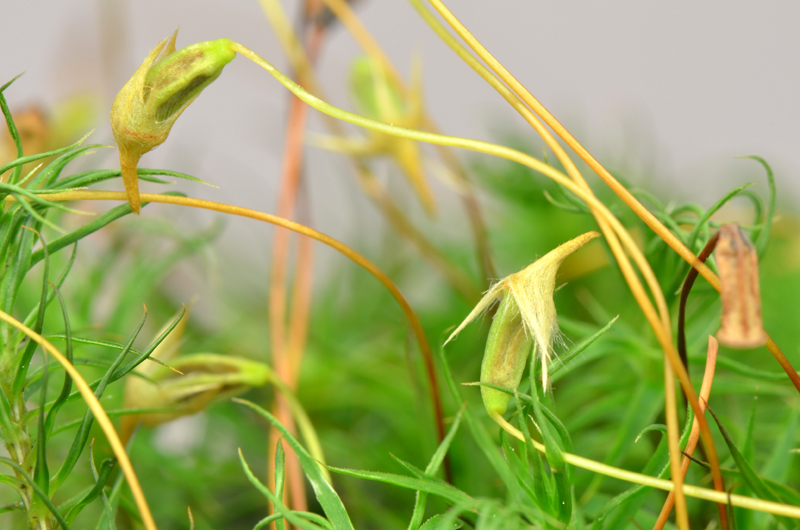If your moss fits the description of 1a. click the species name which appears in blue to continue to the species page. If your moss does not fit that description move on and read 1b. In some instances instead of a species name at the end of a description a genus name will be present. Click on the genus and a further species key will be presented.
Use of a hand lens is very helpful.
1a. Moss is white to very light green, found growing in dense rounded tuft with leaves that role and become tubular in their top half.—–Leucobryum glaucum
1b. Moss is light green to dark green, purple, or yellow to brown, but not in large dense tufts.—– 2.
2a. Found growing on rocky shelfs or rocky crevices with round capsules, capsules have indented ribs running length wise resembling a mini pumpkin.—–Bartramia pomiformis
2b. Capsules do not resemble round pumpkins, instead, they are more elongated, curved, inclined, or even tear drop shaped.—3.
3a. Capsules very large, tear drop in shape and larger than the normal leaves which are tongue shaped. Capsule surrounded by long skinny leaves which look like hair growing around them.—–Diphyscium foliosum
3b. Capsules are smaller than leaves and do not resemble tear drops. leaves are lanceolate, lanceolate-falcate, narrow lanceolate, or ovate—–4.
4a. Leaves are complanate, lanceolate, with a strong mid-rib that ends in the apical cells. Leaves also look as if they have a pocket on one side of the mid-rib in the lower half of the leaf (Figure 1.0).—–Fissidens
4b. Leaves are not as above or if lanceolate lack the pocket like structure.—–5.
5a. Leaves are ovate 1-2 mm long. Commonly found with slender upright capsules that have only 4 peristome teeth. Generally found on rotted logs and stumps. —-Tetraphis pellucida
5b. Capsules when present have more than 4 peristome teeth. Leaves if ovate are greater then 2 mm long.—–6.
6a. Moss commonly growing on tree branches in small dense tufts. Capsules of the moss have 8 conspicuous ribs running lengthwise. —– 7.
6b. Mosses growing on other substrates such as rocks, soil, and base of trees but not tree branches.—–8.
7a. Capsules immersed and hidden among the leaves. —– Orthotrichum sordidum.
7b. Capsules projected above the leaves on seta. —– Ulota crispa.
8a. Moss found in disturbed areas such as; a gravel road, road side, or a trail. —–9.
8b. Moss found in relatively undisturbed areas such as the forest floor. —–10.
9a. Moss is light green with 1-2mm long leaves that are keeled with inward rolled margins in the upper portion. Grows in lose tufts. —–Weissia controversa.
9b. Moss is dark green or purplish, leaves keeled and gradually tapering to a point. Matured capsules have a purplish tint. —–Ceratodon purpureus.
10a. Mosses generally found in moist areas. leaves are erect and wide spreading when moist, and often fold up when dry. Leaves are generally roundish to oblong, and thin. Midrib is conspicuous, as well as a small thickened border that runs along the leaves margins. —– Mnium.
10b. Mosses generally found in dryer habitats, leaves are not as above. —– 11.
11a. Leaves are generally at least 5 mm long and lance shaped. Leaves change very little in characteristics when dry or moist. The capsules are boxed shaped and generally with a hairy calyptra (Figure 1.1). —–Polytrichum.
11b. Leaves generally less then 5 mm long, becoming erect when moist but often become contorted or twisted when dry. leaves may be lanced, narrow lanced, or falcate-secund. Capsules when present are not as above. —–12
12a. Leaves are lance shaped, with conspicuous midrib that ends at the apex. When wet leaves spread out, upon drying leaves becoming strongly contorted and curled. —–13.
12b. Leaves are narrowly lanced, looking more like a hair, Leaves are often secund. —–14.
13a. Leaves when wet become wavy with a midrib which makes up approximately 1/4 of the leaf width. —–Atrichum altecristatum.
13b. Leaves when wet remain straight with a midrib which makes up approximately 1/3 of the leaf width. —–Atrichum angustatum.
14a. Moss is generally no taller then 1 cm, and grows in light green carpets on thin layers of soil. —–Ditrichum pallidum.
14b. Moss is generally at least 1 cm tall. —–Dicranum

